Your home might be at risk if you spot unexplained water stains, peeling or bubbling paint, or warped floors. These signs often indicate underlying moisture problems requiring immediate action. Musty odors can signal hidden mold, while increased water bills may hint at plumbing leaks. Don't overlook damp insulation or cracks in walls and foundations, as they suggest significant water damage. Rusty pipes further compromise your plumbing integrity. Regular inspections and maintenance are crucial to preventing costly repairs and health risks. To guarantee your home's safety, understanding these signs is critical, and you'll uncover more important insights ahead.
Unexplained Water Stains
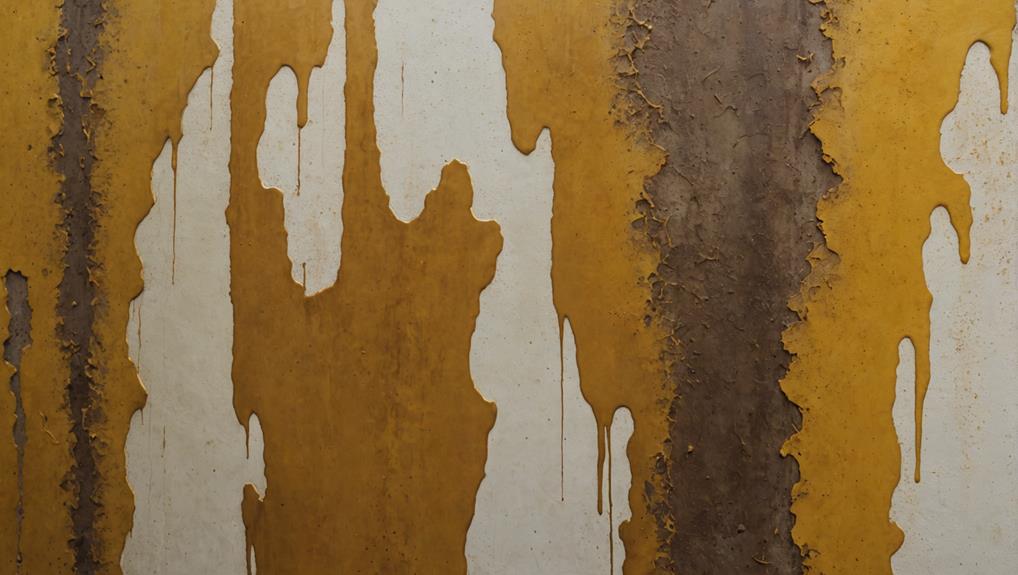
Have you ever noticed unexplained water stains on your walls or ceilings? These marks often indicate underlying issues that shouldn't be ignored. One common culprit is a leaky roof. When shingles wear out or damage occurs, water can infiltrate your home, leading to unsightly stains. It's vital to regularly inspect your roof for wear, especially after severe weather, to catch potential leaks before they escalate.
Alternatively, faulty plumbing could be the source of those mysterious stains. Leaks from pipes hidden within walls or ceilings often manifest as discoloration. It's important to monitor your plumbing system and address any drips or moisture promptly. Ignoring these signs can result in mold growth and structural damage, which can be costly to repair.
If you find yourself staring at those stains, take a closer look. They're not just a cosmetic issue; they're a signal from your home that something's amiss. Whether it's a leaky roof or faulty plumbing, addressing these problems quickly will safeguard your home and maintain its integrity. Remember, your home deserves attention, and those stains are worth investigating.
Peeling or Bubbling Paint
Peeling or bubbling paint often signals underlying moisture issues that require immediate attention. Understanding the causes, such as trapped moisture or poor ventilation, can help you identify potential problems before they escalate. Furthermore, implementing effective prevention and maintenance strategies will safeguard your walls and prolong the life of your paint finish.
Causes of Peeling Paint
Often, homeowners might notice peeling or bubbling paint as a sign of underlying issues that could lead to more significant damage if left unaddressed. One primary cause of this phenomenon is excess paint moisture, which can occur when humidity levels rise or when water infiltrates walls. When moisture seeps beneath the paint layer, it disrupts the bond between the paint and the surface, causing it to lose adhesion and ultimately peel away.
Another contributing factor is surface deterioration. If the underlying material, like wood or drywall, is compromised—due to rot or mold—the paint can't adhere as effectively. This deterioration often results from prolonged exposure to moisture, whether from leaks, condensation, or inadequate ventilation. Furthermore, poor application techniques, such as painting over dirty or damp surfaces, can worsen the problem.
As you inspect your home, take note of any bubbling or peeling. It's not just cosmetic; it signals that the paint's integrity has been compromised, and addressing these root causes should be a priority to avoid further damage.
Prevention and Maintenance Tips
To maintain the integrity of your paint and prevent peeling or bubbling, it's fundamental to address moisture issues proactively and guarantee proper surface preparation. Begin by performing seasonal inspections to identify any signs of water intrusion, such as leaks or damp spots. Early detection is imperative; once moisture seeps into the wall, it can compromise the paint layer, leading to unsightly damage.
Implementing effective waterproofing techniques is another significant step. Consider applying a high-quality waterproof sealant to areas prone to moisture, such as basements or exterior walls. This barrier not only protects your surfaces but likewise prolongs the life of your paint.
Before painting, verify surfaces are clean, dry, and free from mildew. Sanding and priming are important, as they create a smooth foundation that improves paint adhesion. If you're painting in a humid environment, timing is everything; wait for conditions to improve before applying paint.
Lastly, always choose paint specifically designed for high-moisture areas. These formulations resist peeling and bubbling, safeguarding your home's aesthetic. By following these strategies, you'll maintain a beautiful finish while protecting your home from the hidden dangers of water damage.
Warped or Buckled Floors
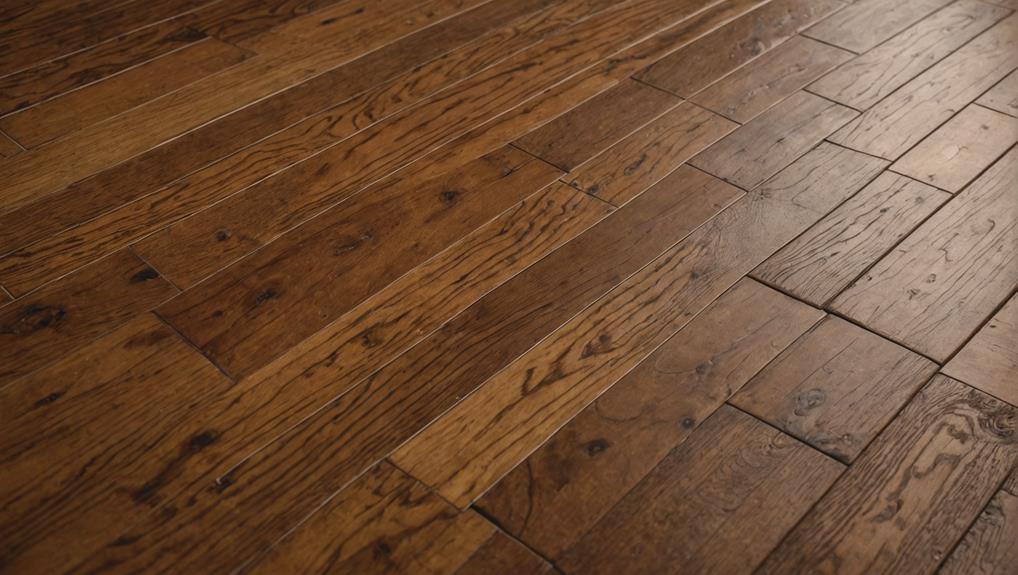
If you notice warped or buckled floors, it's essential to understand the underlying causes, which often stem from moisture exposure. Identifying the signs of buckling can help you address the issue before it escalates. Moreover, implementing effective prevention and maintenance strategies will protect your flooring from future water damage.
Causes of Warped Flooring
Warped flooring can be a frustrating issue for homeowners, often resulting from a combination of environmental factors and improper installation. One primary culprit is excess moisture, which can seep from various sources such as leaking pipes, poor drainage, or even high humidity levels. When flooring materials, particularly hardwood or laminate, absorb this moisture, they expand. If the moisture isn't addressed promptly, this expansion can lead to warping or buckling.
Improper installation can intensify the problem. If flooring materials aren't acclimated to the environment before installation, they may not adjust properly to the home's humidity levels. Furthermore, inadequate spacing around the edges can restrict movement, forcing the planks to buckle.
Temperature fluctuations can likewise contribute to warped floors. Rapid changes can cause certain materials to contract or expand unevenly, resulting in an uneven surface.
Understanding these causes can help you take preventive measures. Regularly checking for moisture sources and ensuring proper installation techniques can save you from the hassle of dealing with warped floors in the future. By addressing these issues early, you can maintain the integrity of your flooring and protect your home.
Identifying Buckling Signs
Often overlooked, the signs of buckling floors can be subtle yet vital indicators of underlying moisture issues. When you notice your floors bulging, warping, or developing gaps, it's crucial to act swiftly. Buckling typically occurs when moisture penetrates the flooring material, causing it to expand. This expansion not only disrupts the aesthetic appeal but likewise compromises the structural integrity of your home.
To effectively assess buckling, start with moisture detection. Use a moisture meter to evaluate the levels beneath the surface. If readings exceed acceptable thresholds, it's a clear signal that water intrusion is present. Pay attention to the areas where the buckling is most pronounced, as they often correlate with leaks or inadequate ventilation.
Moreover, inspect the subflooring. If it feels soft or spongy underfoot, this deterioration indicates deeper issues that could escalate if left unchecked. Remember, addressing these signs early can prevent extensive damage and costly repairs. Ultimately, understanding the nuances of buckling floors empowers you to safeguard your home's longevity and comfort, ensuring that it remains a sanctuary for you and your loved ones.
Prevention and Maintenance Tips
While it may seem intimidating, taking proactive measures can greatly reduce the risk of warped or buckled floors in your home. Start with implementing effective waterproofing techniques. Applying sealants and membranes in areas prone to moisture, like basements or crawl spaces, can protect your flooring from water intrusion.
Routine inspections are crucial. Check for leaks around windows, pipes, and appliances. Even minor leaks can lead to significant water damage if left unaddressed. During these inspections, pay attention to humidity levels. Ideally, indoor humidity should be between 30-50%. Use dehumidifiers in damp areas to maintain this range.
Additionally, consider upgrading your flooring materials. If you live in a high-moisture environment, opt for water-resistant options such as vinyl or tile rather than hardwood.
Musty Odors in Rooms
In many homes, musty odors can signal underlying water damage that often goes unnoticed. These musty smells are typically a result of moisture accumulation, which can lead to a decline in air quality. When you detect this odor, it's vital to investigate the source immediately, as it may indicate lingering dampness behind walls or under flooring.
The presence of moisture creates an ideal environment for bacteria and other microorganisms to thrive, which could compromise your home's air quality. It's not just an unpleasant scent; it can likewise affect your health, particularly for those with respiratory issues. Pay attention to areas like basements, attics, or around appliances where condensation might occur.
Consider using a hygrometer to measure humidity levels in your home. Ideally, indoor humidity should be between 30-50%. If you find consistently high levels, it's a red flag. Addressing the source of moisture—whether it's leaks, inadequate ventilation, or poor insulation—is vital in mitigating these musty odors. By staying proactive, you can maintain a healthier living environment and protect your home from further water damage.
Mold Growth in Hidden Areas
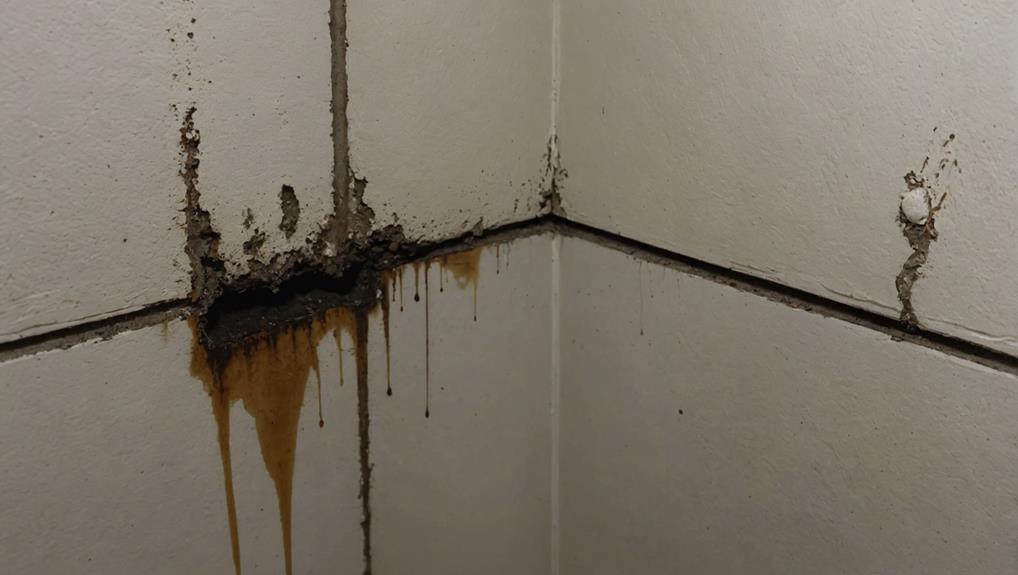
Musty odors can be an early warning sign of mold growth lurking in hidden areas of your home. Often, mold thrives in dark, damp places like behind walls, under sinks, or in basements, where it's less likely to be noticed. If you're experiencing these odors, a detailed mold inspection is crucial to identify the source and extent of the issue.
Mold can pose serious health effects, especially for individuals with allergies, asthma, or compromised immune systems. It releases spores into the air, which can trigger respiratory issues and other health complications. The longer mold goes unchecked, the more pervasive it can become, leading to significant structural damage as well.
To safeguard your home and health, don't ignore those subtle signs. Regular inspections, particularly in high-humidity areas, can help catch mold growth early. If you suspect hidden mold, consider consulting a professional for a thorough mold inspection. They can assess the situation accurately, ensuring you address any potential health risks while protecting your living space. Your home should be a sanctuary, free from the unseen dangers of mold.
Increased Water Bills
An unexpected spike in your water bills can serve as a red flag, indicating potential hidden leaks within your plumbing system. If you notice a sudden increase, it's vital to investigate the cause promptly. Often, the culprits are leaky appliances or unnoticed plumbing issues that can waste a significant amount of water over time.
Start by examining your appliances, particularly the washing machine, dishwasher, and water heater. Look for any signs of moisture or pooling water. Even a minor leak can lead to inflated bills and long-term damage if left unaddressed. Next, inspect your plumbing fixtures, including faucets and toilets, for drips or constant running water. These small issues can add up quickly, driving your costs higher.
Furthermore, keep an eye on your water meter. If you're not using water but the meter continues to move, it's a clear indication of a leak somewhere in your system. By staying vigilant and addressing any signs of water loss early, you can prevent not only financial strain but also potential water damage in your home. Regular maintenance and timely repairs can save you both money and headaches down the line.
Damp or Wet Insulation
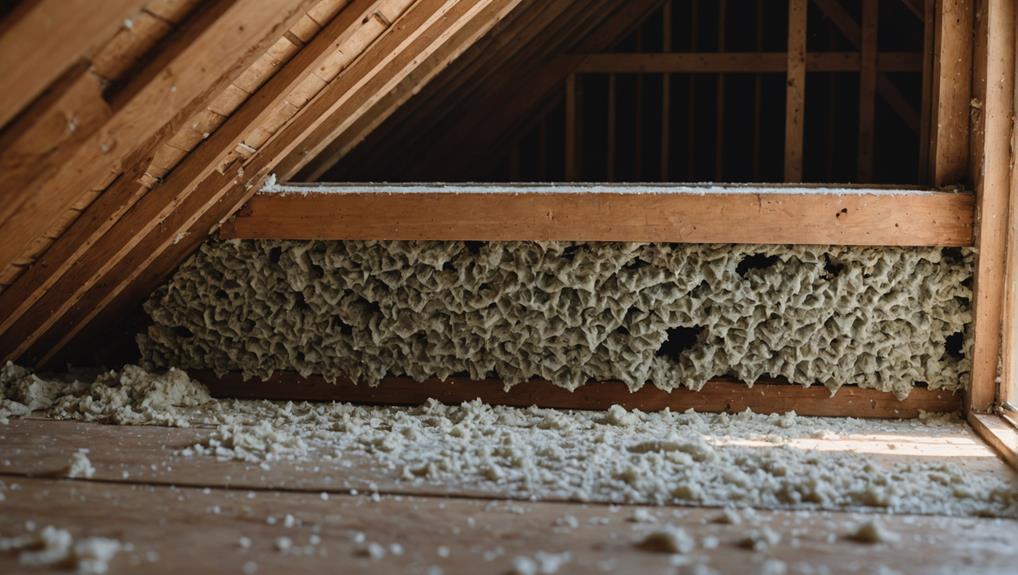
Sometimes overlooked, damp or wet insulation can be a clear indicator of water damage within your home. When insulation materials become saturated, they lose their effectiveness, leading to increased energy costs and potential mold growth. Moisture detection in insulation can help you identify and address these issues before they escalate.
Here's a quick reference table to help you understand the types of insulation materials and their susceptibility to moisture:
| Insulation Material | Moisture Resistance | Common Issues |
|---|---|---|
| Fiberglass | Moderate | Mold, reduced R-value |
| Cellulose | Low | Mold, sagging |
| Spray Foam | High | Limited moisture impact |
| Rockwool | High | Water absorption, but fire-resistant |
If you notice dampness in your insulation, it's essential to investigate further. Look for leaks, condensation, or inadequate ventilation. Addressing these moisture issues promptly can save you from costly repairs and health risks down the line. Always remember: a simple check can protect your home from the hidden dangers of water damage.
Cracked Walls or Foundations
Cracked walls or foundations can signal significant underlying issues related to water damage. When you notice these cracks, it's vital to assess their nature and extent, as they may indicate foundation settlement. This condition arises when the soil beneath your home becomes saturated, leading to shifts that compromise the structural integrity of your property.
You might observe vertical cracks, which could be less alarming, but horizontal or diagonal cracks often suggest more serious concerns. These may allow moisture to penetrate, creating an environment favorable to mold growth and further structural degradation. It's important to monitor not just the cracks but likewise any accompanying signs, such as bulging walls or doors that stick.
Ignoring these indicators could lead to costly repairs down the line. It's a good idea to consult a professional who can evaluate the situation accurately. A qualified inspector can determine whether the foundation damage is a result of water intrusion or other factors, allowing you to take the necessary steps to restore your home's safety and stability. Remember, addressing these issues promptly can save you from more severe consequences in the future.
Rusty Pipes and Fixtures
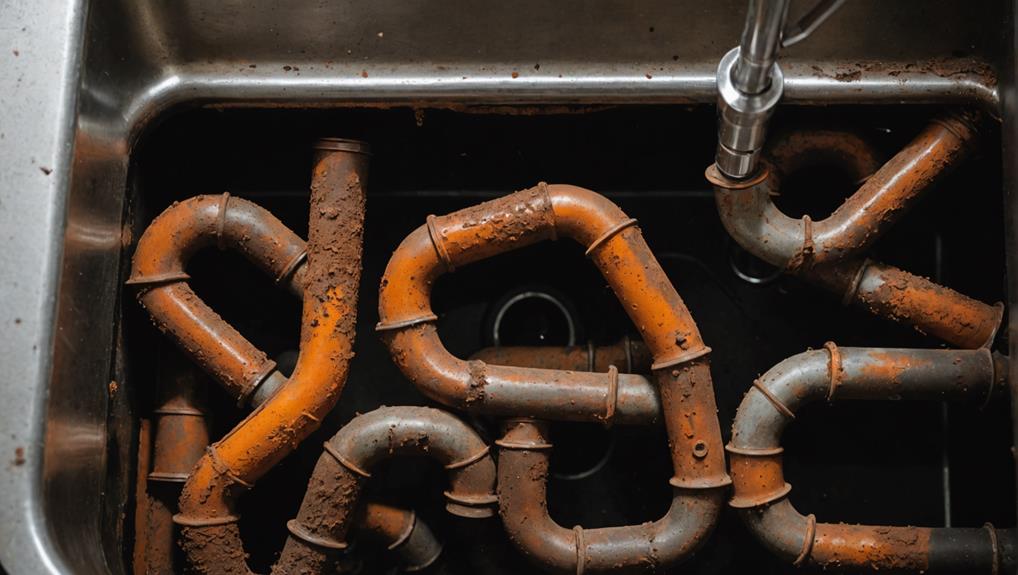
Rusty pipes and fixtures can serve as a clear warning sign of water damage lurking within your home. When you notice rust, it's essential to understand that this often indicates pipe corrosion, which can compromise the integrity of your plumbing system. Corroded pipes not only diminish water quality but can additionally lead to fixture leaks, causing further damage to surrounding areas.
You might find rust stains around faucets, showerheads, or even on the walls near plumbing fixtures. These stains aren't just unsightly; they're symptomatic of a larger issue. Over time, rust can weaken the pipes, resulting in leaks that can escalate into significant water damage if left unaddressed.
To mitigate these risks, it's critical to conduct regular inspections of your plumbing. Look for discoloration, moisture accumulation, or unusual water pressure fluctuations. If you encounter these signs, don't hesitate to consult a plumbing professional. Early intervention can save you from costly repairs and preserve the health of your home. Remember, addressing rusty pipes and fixtures promptly is key to maintaining a safe and dry living environment.
Conclusion
As you inspect your home, be alert for those subtle signs of water damage lurking just beneath the surface. The faint musty odor or the unexpected spike in your water bill could be the tip of an ominous iceberg. If warped floors and peeling paint catch your eye, ask yourself: what lies hidden within the walls? Ignoring these clues may lead to costly repairs down the road. Stay vigilant—your home's safety depends on it.
